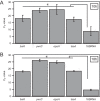Direct Comparison of Physical Properties of Bacillus subtilis NCIB 3610 and B-1 Biofilms
- PMID: 26873313
- PMCID: PMC4959484
- DOI: 10.1128/AEM.03957-15
Direct Comparison of Physical Properties of Bacillus subtilis NCIB 3610 and B-1 Biofilms
Abstract
Many bacteria form surface-attached communities known as biofilms. Due to the extreme resistance of these bacterial biofilms to antibiotics and mechanical stresses, biofilms are of growing interest not only in microbiology but also in medicine and industry. Previous studies have determined the extracellular polymeric substances present in the matrix of biofilms formed by Bacillus subtilis NCIB 3610. However, studies on the physical properties of biofilms formed by this strain are just emerging. In particular, quantitative data on the contributions of biofilm matrix biopolymers to these physical properties are lacking. Here, we quantitatively investigated three physical properties of B. subtilis NCIB 3610 biofilms: the surface roughness and stiffness and the bulk viscoelasticity of these biofilms. We show how specific biomolecules constituting the biofilm matrix formed by this strain contribute to those biofilm properties. In particular, we demonstrate that the surface roughness and surface elasticity of 1-day-old NCIB 3610 biofilms are strongly affected by the surface layer protein BslA. For a second strain,B. subtilis B-1, which forms biofilms containing mainly γ-polyglutamate, we found significantly different physical biofilm properties that are also differently affected by the commonly used antibacterial agent ethanol. We show that B-1 biofilms are protected from ethanol-induced changes in the biofilm's stiffness and that this protective effect can be transferred to NCIB 3610 biofilms by the sole addition of γ-polyglutamate to growing NCIB 3610 biofilms. Together, our results demonstrate the importance of specific biofilm matrix components for the distinct physical properties of B. subtilis biofilms.
Copyright © 2016, American Society for Microbiology. All Rights Reserved.
Figures






Similar articles
-
Importance of the biofilm matrix for the erosion stability of Bacillus subtilis NCIB 3610 biofilms.RSC Adv. 2019 Apr 11;9(20):11521-11529. doi: 10.1039/c9ra01955c. eCollection 2019 Apr 9. RSC Adv. 2019. PMID: 35520264 Free PMC article.
-
BslA(YuaB) forms a hydrophobic layer on the surface of Bacillus subtilis biofilms.Mol Microbiol. 2012 Jul;85(1):51-66. doi: 10.1111/j.1365-2958.2012.08094.x. Epub 2012 May 28. Mol Microbiol. 2012. PMID: 22571672
-
Biofilm hydrophobicity in environmental isolates of Bacillus subtilis.Microbiology (Reading). 2021 Sep;167(9). doi: 10.1099/mic.0.001082. Microbiology (Reading). 2021. PMID: 34486975
-
Beneficial biofilm formation by industrial bacteria Bacillus subtilis and related species.J Biosci Bioeng. 2006 Jan;101(1):1-8. doi: 10.1263/jbb.101.1. J Biosci Bioeng. 2006. PMID: 16503283 Review.
-
Molecular mechanisms involved in Bacillus subtilis biofilm formation.Environ Microbiol. 2015 Mar;17(3):555-65. doi: 10.1111/1462-2920.12527. Epub 2014 Jul 7. Environ Microbiol. 2015. PMID: 24909922 Free PMC article. Review.
Cited by
-
ABC transporter genes ABC-C6 and ABC-G33 alter plant-microbe-parasite interactions in the rhizosphere.Sci Rep. 2019 Dec 27;9(1):19899. doi: 10.1038/s41598-019-56493-w. Sci Rep. 2019. PMID: 31882903 Free PMC article.
-
Swarming bacteria undergo localized dynamic phase transition to form stress-induced biofilms.Elife. 2021 Mar 16;10:e62632. doi: 10.7554/eLife.62632. Elife. 2021. PMID: 33722344 Free PMC article.
-
Bacillus subtilis biofilm formation and social interactions.Nat Rev Microbiol. 2021 Sep;19(9):600-614. doi: 10.1038/s41579-021-00540-9. Epub 2021 Apr 6. Nat Rev Microbiol. 2021. PMID: 33824496 Review.
-
Nonlinear rheological characteristics of single species bacterial biofilms.NPJ Biofilms Microbiomes. 2020 Apr 14;6(1):19. doi: 10.1038/s41522-020-0126-1. NPJ Biofilms Microbiomes. 2020. PMID: 32286319 Free PMC article.
-
Titanium complexes affect Bacillus subtilis biofilm formation.RSC Med Chem. 2023 May 2;14(5):983-991. doi: 10.1039/d3md00075c. eCollection 2023 May 25. RSC Med Chem. 2023. PMID: 37252093 Free PMC article.
References
-
- Flemming H-C, Wingender J. 2010. The biofilm matrix. Nat Rev Microbiol 8:623–633. - PubMed
Publication types
MeSH terms
Substances
LinkOut - more resources
Full Text Sources
Other Literature Sources
Molecular Biology Databases

